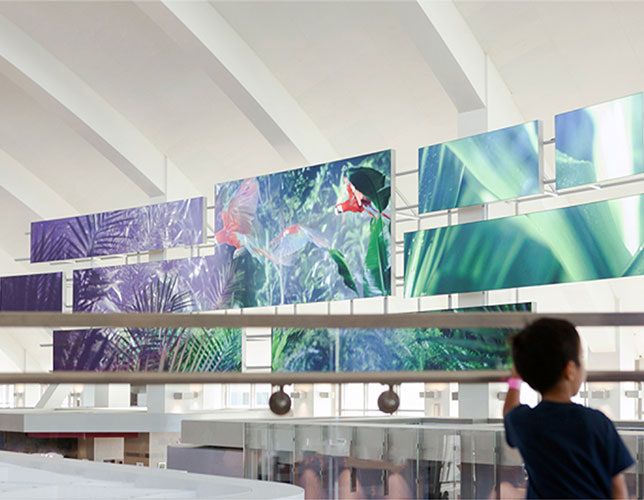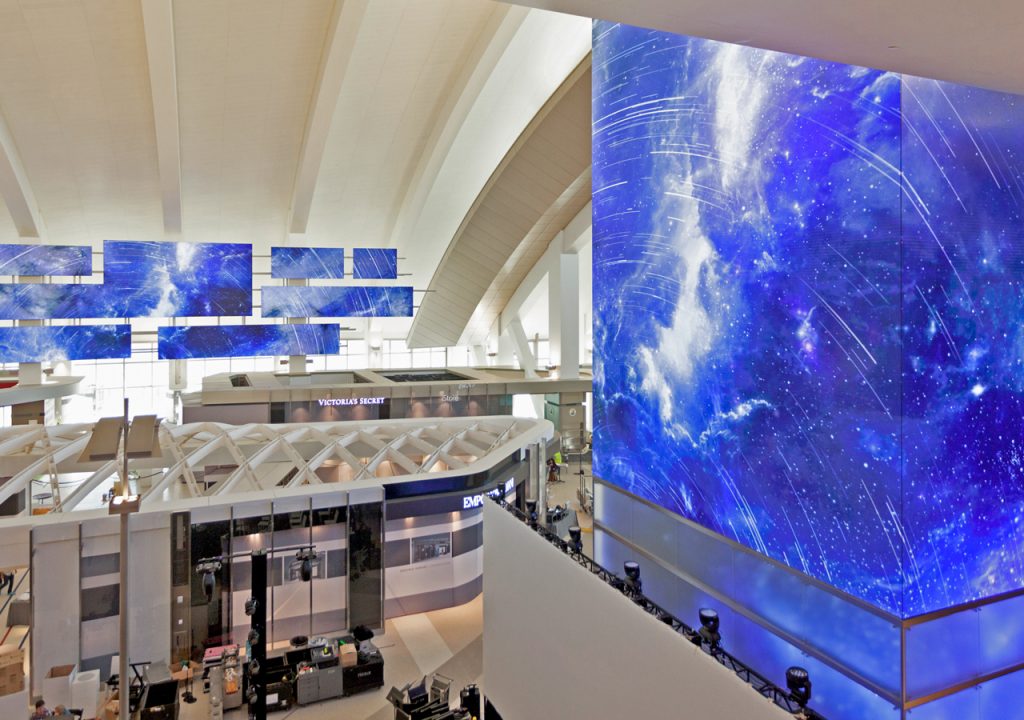An LAX Case Study: Evolving Design and Why It Pays to Invest in the Travel Experience
Posted by Sasha Bailyn on Thursday, March 31st, 2016
A project at Los Angeles International Airport (LAX) is providing a hint to investors and major property managers on why it pays to make large-scale commercial venues engaging and interesting.. When you first think of airport design, there are numerous considerations: traffic flows, landing space for planes, retail, and how to keep people moving in and out of the space efficiently. But the design team behind the new Tom Bradley International Terminal at LAX had a bigger vision. The resulting Integrated Environmental Media System (IEMS) is being recognized with a Thea Award in this year’s lineup.
The IEMS is what has been described as “an unprecedented passenger experience and a new source of non-aeronautical revenues for the facility.” Both of these points are important for airports which struggle with tight margins, declining revenues, and flagging customer satisfaction. Between less leg room on planes and today’s demanding (but necessary) security regulations, the idea of travel fills most passengers with dread. By using the IEMS to lighten the mood and infuse some pleasure back into the travel experience, LAX is providing a powerful model of what can be accomplished with strategic planning and forethought.

At a high level, the IEMS is the most advanced multimedia environment at a U.S. airport. The IEMS has seven media features, including Welcome and Bon Voyage Walls, a four-sided Time Tower, and portals that guide passengers to their departure gates. The IEMS is supported by an intelligent show control system that enables mapping content onto unique, very large-scale, multi-dimensional media surfaces.
As the Thea judges noted, “Arriving and departing passengers are mesmerized by the beautiful content floating throughout this massive canvas. The content captures the culture of Los Angeles and, depending on the destinations of upcoming departures, will periodically change to reflect those destinations.”
They go on to say: “Since its opening, the project has received global attention as the most provocative example of a fully integrated, intelligent media environment. It’s a space where immersive media and ambient storytelling don’t demand attention – but do reward it. It’s the perfect “hello” and “goodbye” to travelers from all over the world and that’s why the Thea Nominating Committee recommends an Award for Outstanding Achievement to the Integrated Environmental Media System at LAX.”
Similar ideas are now being rolled out around the world. The base concept is now under design development, or even already under construction, with the same concept in other airports, museums and themed attractions. The Thea judges finish their assessment by saying, “The base idea is not new, but the Integrated Environment Media System at LAX has been executed with such creative and technical excellence that it has redefined the field, and is fast becoming a widely-admired and replicated achievement. It has also improved the airport visitor experience: Studies show that travelers tend to arrive early at the terminal to enjoy the media.”
It’s that final sentence which will stop most business people and designers in their tracks: IEMS has created something so beautiful, so enticing, that travelers are braving the airports just to see it. It has become an experience that’s both integrated into a visit with the terminal and something that stands out on its own.

The creative and technical wizards behind IEMS included media studio Moment Factory and programming and show control designers Smart Monkeys. We had the opportunity to chat with Stephan Villet of Smart Monkeys, who created the system that supports mapping content onto the seven large-scale, multi-dimensional media surfaces; interactive programming; data-generated content; and multi-feature scheduling. According to Villet, the goals of the project were audacious. “As per the designers’ intent (MRA/Sardi), the goal of the IEMS is to enhance the passengers’ experience and bring back the magic and romance of travel. The scale of the media features is balanced by the slow pace and incredible beauty of the content pieces.”
He goes on to explain, “We created a place where passengers’ journeys start long before they board their planes.”
From a technical perspective, the technology driving the experience is sophisticated and central to the way that the terminal was designed. “The same way the media displays are highly integrated within the building architecture, the IEMS content delivery system merges with the airport technical topology.” In particular, there’s a powerful aspect of interactivity that helps capture travelers’ attention. “The Time Tower, the biggest of the media features, detects proximity movements using laser scanners. Some content pieces react to nearby passengers in various ways. The system also monitors the position and speed of the elevator cabins traveling inside the tower so the content can be tied to them.”
The technology doesn’t just set the stage for the main terminal. It also helps shepherd passengers to their ultimate destinations by a series of portals. “The Portals offering access to the concourses also detect movement and interact with passengers walking by, altering visual and audio content. The core controller is connected to the flight information system and content is triggered based on departure and arrival data such as destination cities.”
In other words, depending on where you’re headed you may see images of the Cliffs of Moher in Ireland, an iconic image of the Eiffel Tower, or the inviting sandy beaches of Mauritius. The content is strategically designed to reimagine travel as a fully integrated experience. Travelers’ mindsets begin to shift before their planes take flight.
There are numerous lessons for organizations undertaking this type of project. One is the importance of adapting the experience design and entertainment design worlds to the airport environment. Villet says, “The environment and partners in that type of project (transportation hub) are fairly different than the ones we’re used to working with in theme parks and other entertainment properties. We had to understand their operations and security requirements and provide appropriate methods and technologies to bring our contribution to this enormous endeavor.”

Another big lesson is that learning goes both ways. Entertainment design can teach businesses new ways of engaging. But designers also learn a lot from interacting with clients in other realms. “In the end, it is very exciting to see how much entertainers can bring to other industries but also to realize that we have a lot to learn from those. There are substantial technologies and processes that we discovered during that project which we think would be very valuable for our theme parks projects,” explains Villet.
Finally, the IEMS is a testament that people care about their experience. It’s natural to look at an airport and think that the only things that matter are streamlined, efficient passenger processing. That’s important, but the beauty and environment matter as well. You can add a lot of delight and eliminate significant stress by seeking to create an experience around the best part of an airport visit: the destination travelers are about to see. From airports to malls, the teams driving these projects can learn a great deal from the success that the IEMS and LAX have had in putting the romance back in travel.



 Sign Up For Our Newsletter
Sign Up For Our Newsletter 



